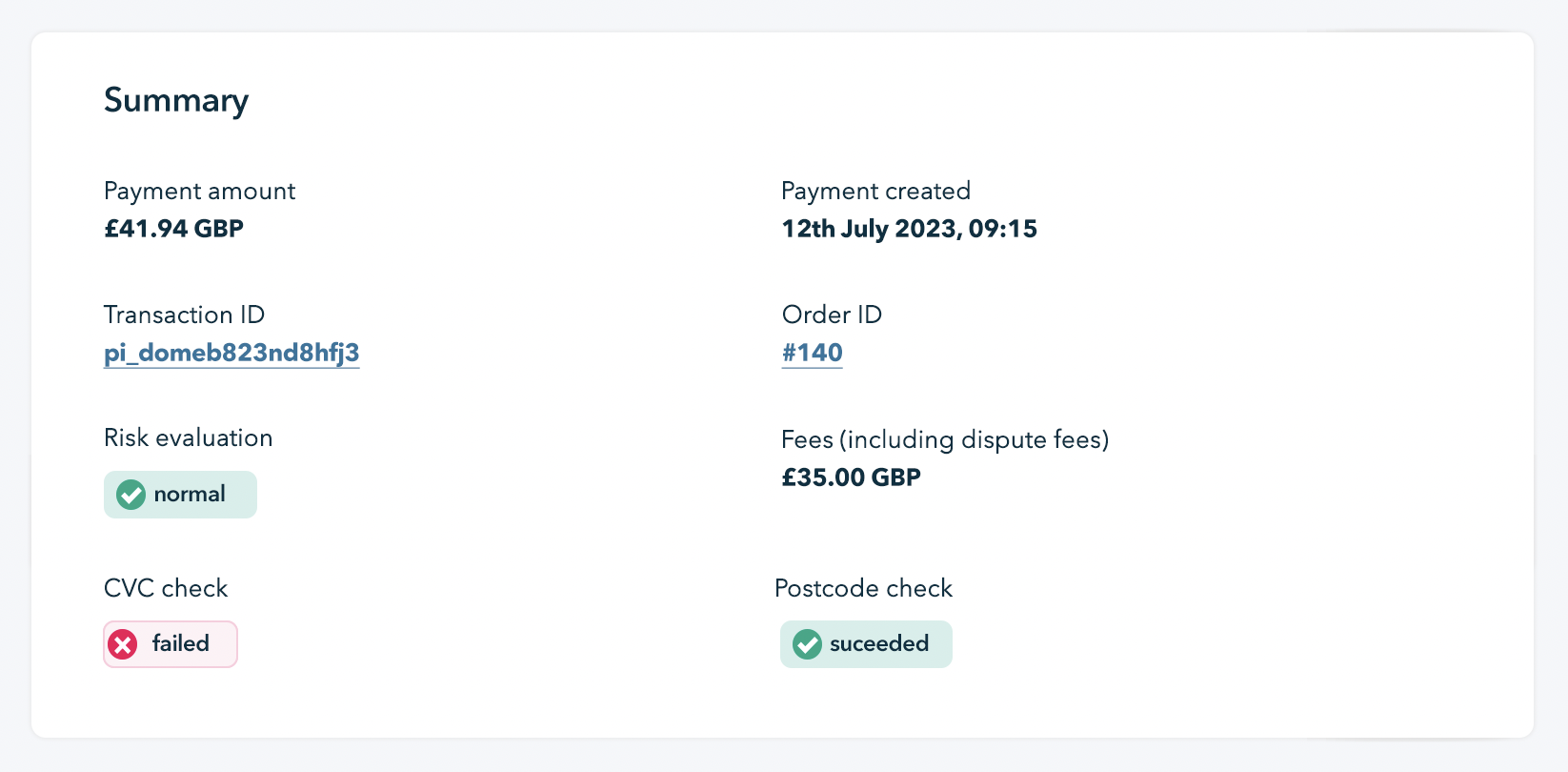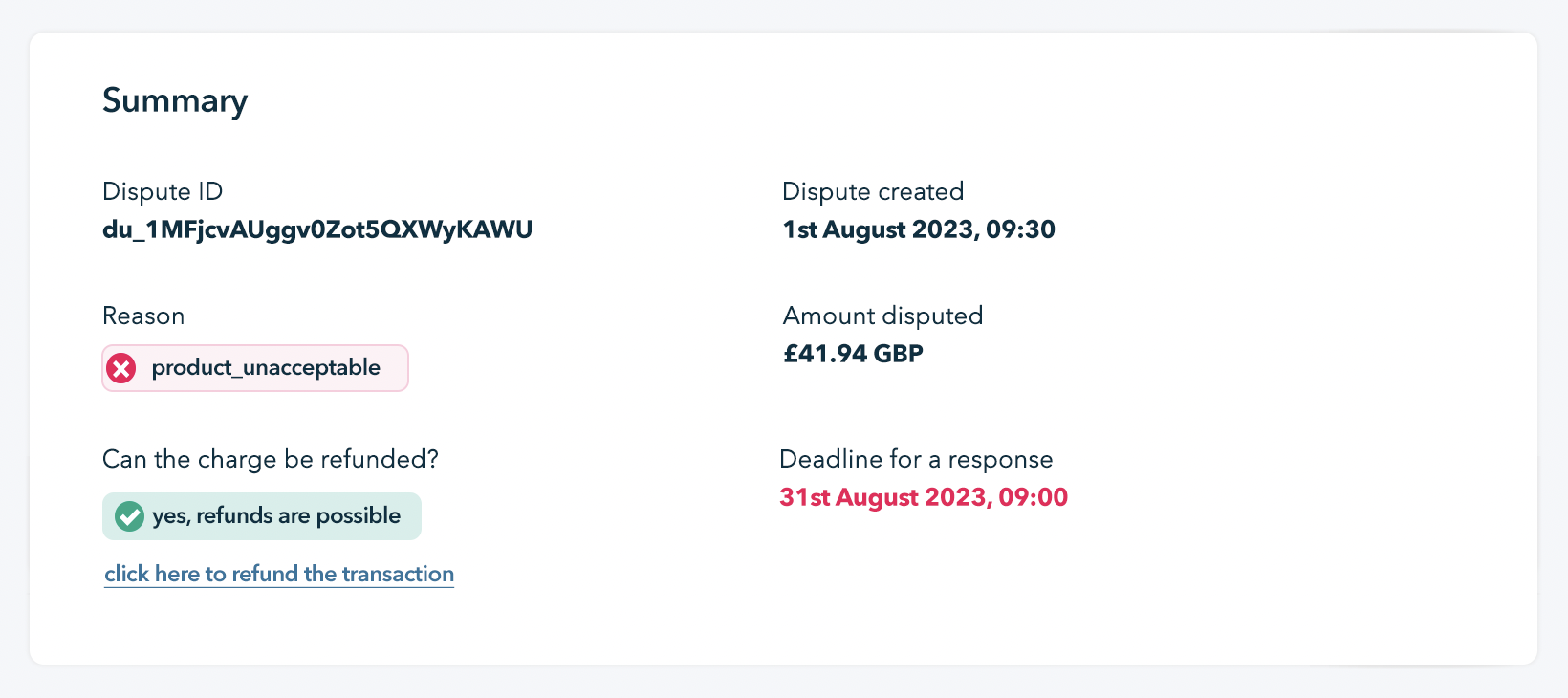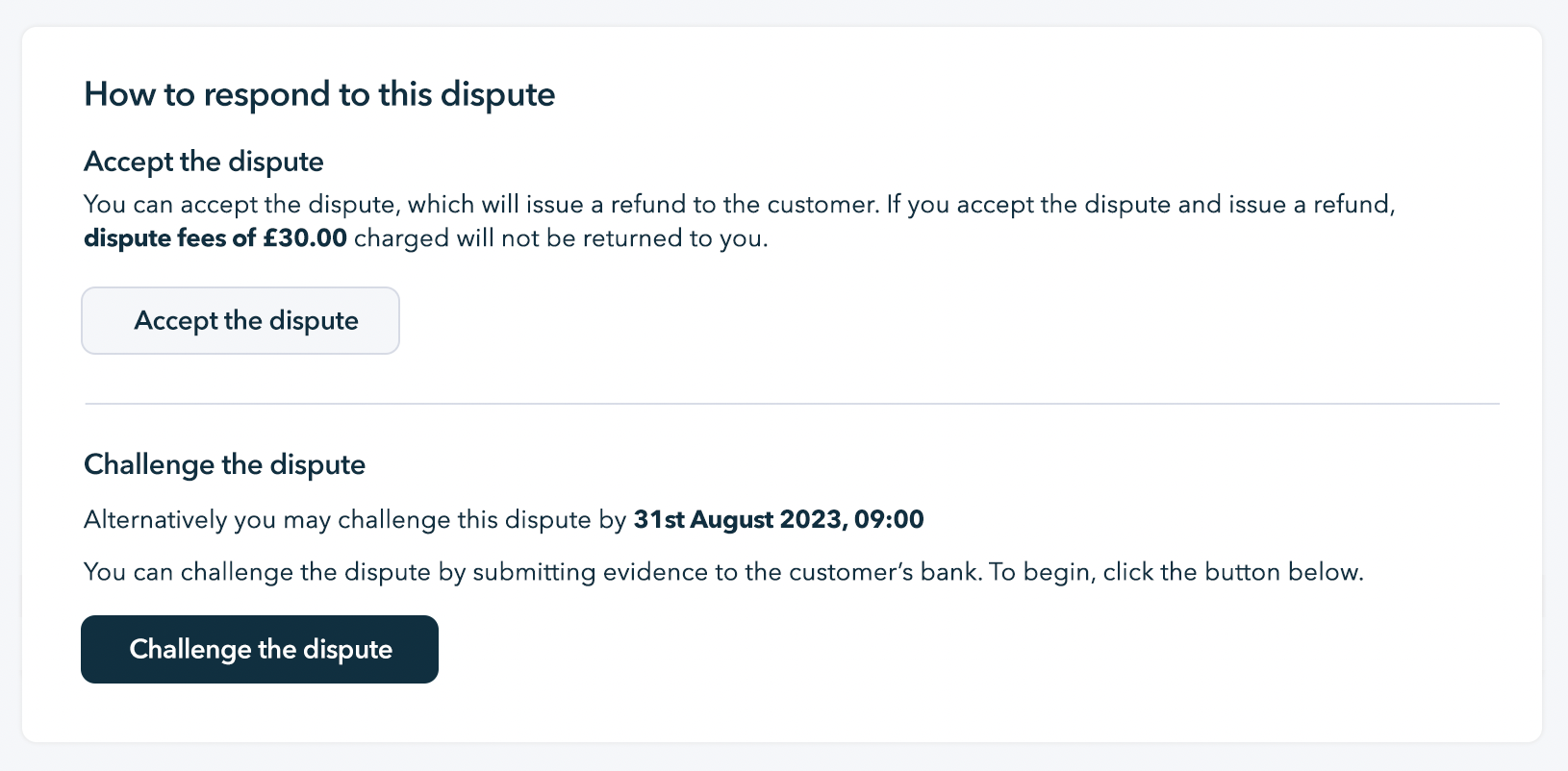Disputes
Card scheme rules allow for a customer to initiate a dispute on a transaction within a certain time period after the transaction has taken place (this will usually be 180 days).
When a transaction on your ShopWired Payments account is subject to a dispute, we'll notify you by email and a notification will be displayed within your ShopWired account and on the corresponding order.
Disputes are an inevitable part of doing business online and can never be avoided 100% of the time and disputes can be initiated by a cardholder for a number of different reasons (detailed below).
This help guide details how to view and manage disputes and how to respond to any disputes that you receive.
When you receive a dispute the funds for the disputed amount will automatically be deducted from your available balance (or, if your balance is zero or already negative, we'll attempt to collect the disputed amount from your bank account). We'll also collect the dispute fee.
Important!
ShopWired Payments does not take any part in the decision making process of disputes, we are only responsible for notifying you when there is a dispute on a transaction and sending any evidence to counter the dispute back to the institution that initiated the dispute.
- Viewing disputes
- Transaction summary
- Dispute summary
- Accepting a dispute
- Challenging a dispute
- Decision notification
- Best practices
Viewing disputes
If the transaction for an order is subject to a dispute, a clear indication will be visible on both the 'view order' page and the 'view transaction' page, providing a link through to the dispute page which provides the full details of the dispute (such as the reason the transaction is disputed).
You can also visit the 'view disputes' page within your ShopWired account which lists all disputes ever initiated on your account, along with the status of each.
Transaction summary

A summary of the original transaction that is subject to the dispute is displayed in this section, along with a link through to the transaction page.
The results of any fraud/risk checks on the transaction are also displayed here (such as whether the postcode registered on the credit/debit card matched the billing address postcode entered when the order was placed.
A fee is charged by ShopWired Payments when a transaction is subjected to a dispute, in accordance with your account's fee profile. The total amount of fees, including the dispute fee, is also displayed in this section.
Dispute summary

A summary of the dispute is shown in this section. It includes the date that the dispute was initiated and the amount of the dispute (which may not always match the amount of the transaction).
When a dispute is initiated, the institute/bank sets a timeframe for when you must respond to the dispute (and provide any evidence you want to provide). If you don't respond to a dispute by this deadline, you are likely to loose the dispute and won't be able to initiate any action or send any evidence for the dispute after the deadline.
If the transaction can still be refunded, without accepting or contesting the dispute, an indication will be shown in this section along with a link for you to issue a refund. This option may not always be available for all disputes.
Important!
Refunding the disputed amount will not remove any dispute fees that you have already been charged
Accepting a dispute

When a dispute is initiated, you can either accept the dispute or challenge it.
To accept a dispute, click the 'accept the dispute' button and the institution/bank will be notified. Dispute fees are not refunded if you accept a dispute.
Challenging a dispute

If you'd like to challenge the dispute then click the 'challenge the dispute' button.
This will take you to a separate page on which you can add evidence to the challenge the dispute. The fields available to enter evidence into are dependent on the type of dispute that's been initiated.
For example, if a dispute is initiated on the basis that the product wasn't received by the customer but you evidence from the courier that the order was delivered, then you will be asked to upload this evidence here.
You can opt to save your evidence at any time without submitting it by clicking the 'save evidence' button. Evidence can only be submitted once so you must ensure that once you click the 'submit evidence' button you are sure that you have included all the necessary evidence.
You must submit your evidence by the deadline shown on the dispute page. After this deadline expires, you won't be able to submit any evidence or be able to challenge the dispute.
Not all fields shown on the dispute evidence page are required, so you don't need to provide all the information that you're asked to if you don't have it available.
Please make sure you follow the dispute best practices shown at the bottom of this help guide before submitting evidence.
Decision notification

After you challenge a dispute and submit your evidence, the dispute page will show the current status. When a dispute is initiated and evidence submitted, the institution/bank notifies ShopWired Payments of the deadline by which it will make a decision which can be viewed here.

If you have won the dispute the status will be displayed as shown above.

If you have lost the dispute, you'll see the dispute status as shown in the example above. ShopWired Payments is not provided further information by the institution/bank as to why you lost a dispute or the factors they considered in making their decision - we are only notified that you have won/lost the dispute.

If the deadline for evidence has expired and you didn't challenge the dispute and provide evidence it's highly likely you'll automatically lose the dispute. In this case, we'll show the dispute status as shown on the example above.
Best practices
You can help to resolve a dispute successfully by following some of the guidance that we've outlined below.
Talk to the customer
Many disputes can be resolved by talking to the customer directly outside of the dispute process. As a first step in any dispute, we'd always recommend getting in touch with the customer to see if their complaint or issue can be resolved directly.
If you can successfully solve the customer's issue, you can ask them to withdraw the dispute by phoning their institution/bank. Once they've done this they will receive a dispute withdrawal letter which you should ask them to send to you and you upload as evidence when challenging the dispute.
There are usually multiple institutions/banks involved in the dispute process and a withdrawal letter cannot be guaranteed to be sufficient evidence on its own for you to win a dispute. We therefore always recommend submitting as much additional evidence as possible even when you have a chargeback withdrawal letter from your customer.
Upload customer communication(s)
Wherever possible, we'd always recommend that you upload copies of any communications you've had with customers about their orders or either prior to or after they place their order. We always recommend taking contemporaneous notes when you speak to customers, particularly if you're speaking to them about a problem with their order, and these also serve as evidence of customer communication. Make sure notes are always dated.
Delivery confirmations
If you're using a courier to delivery orders to customers that tracks their delivery, make sure that you upload any receipts of postage and confirmations of delivery to the dispute. This can help to demonstrate to the institution that ajudicates on the dispute that the item was sent to and received by the customer.
Even if you don't have proof of delivery, we'd still advise that you submit proof of postage where its available.
Proof of product(s)
Customers may initiate a dispute because a product wasn't as described or was otherwise 'unacceptable' (e.g. the item was faulty). If the customer didn't try to return the product or cancel their service before the chargeback was initiated, we'd advise mentioning that in your dispute evidence.
If you sent replacement product(s) to the customer, upload evidence of that too.
You should also upload evidence that demonstrates that the product(s) or service(s) purchased were as described by providing evidence about what you have sold to the customer such as a link to the corresponding item on your website or any additional information like photos.
Refund and returns policy, terms and conditions
Providing evidence of your refund and return policies, and your terms and conditions either by providing links to them on your website or uploading them in the uploads section. You may also like to show a screenshot from your website's checkout to show that the customer indicated they accepted your policies before placing their order.
